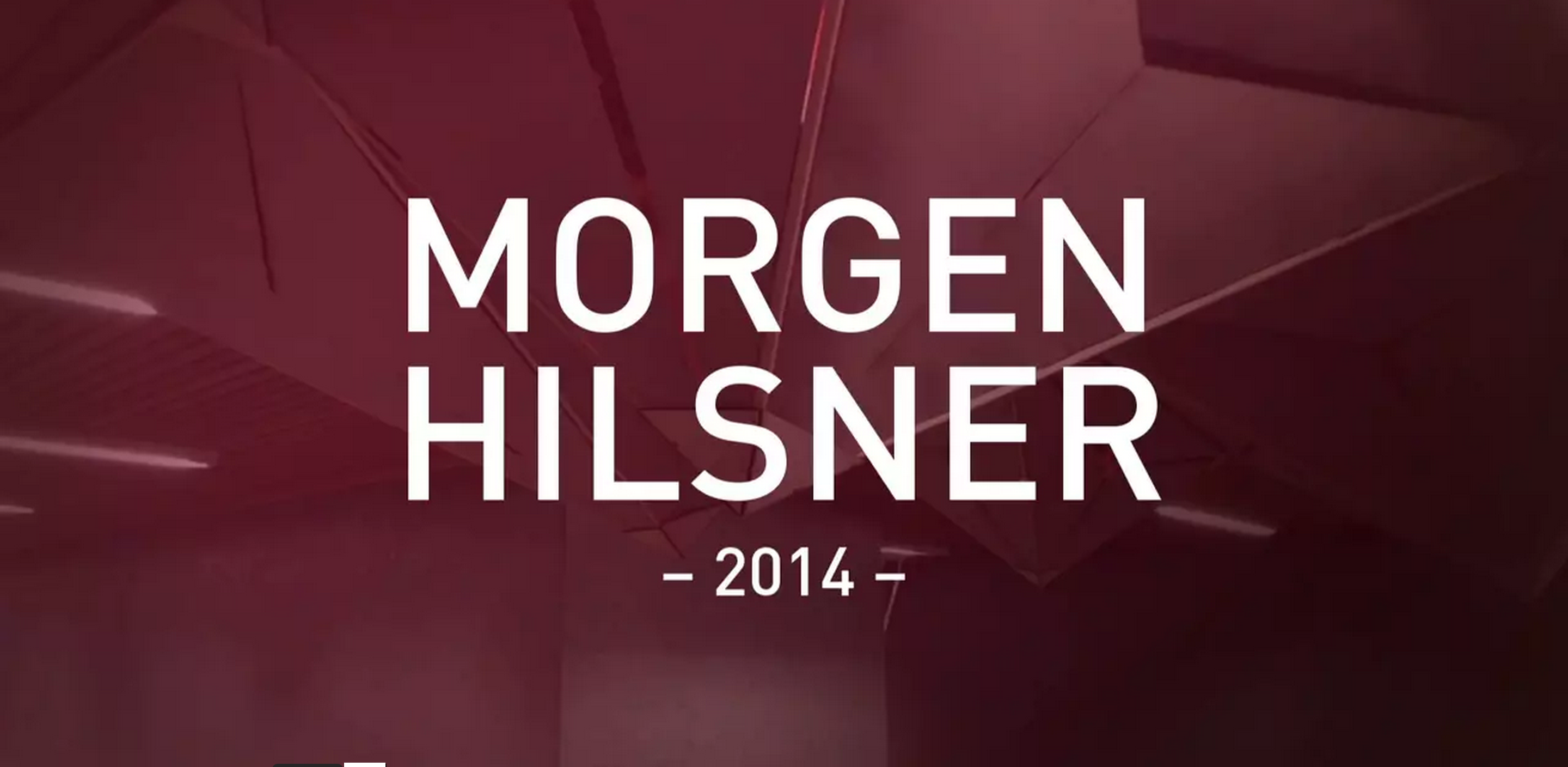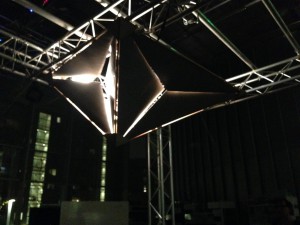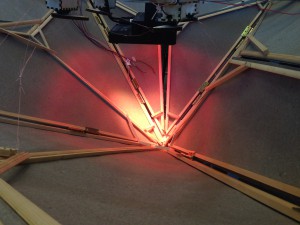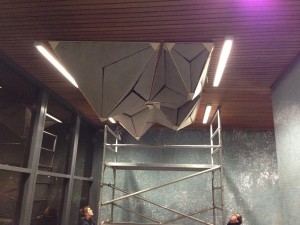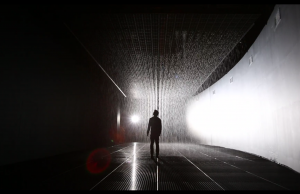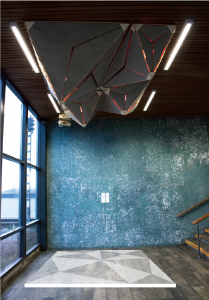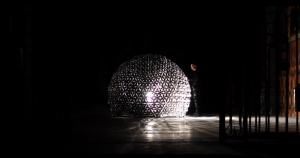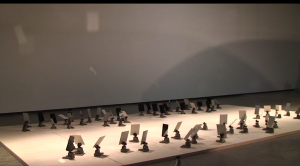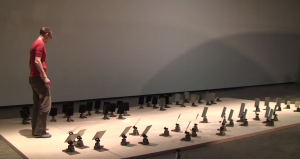“Morgenhilsner” (Morning Greetings, 2014) is an interactive ceiling installation initially installed at Vallensbæk station. During the dark winter, the geometric sculpture greets the station’s passengers with warm light. “Morgenhilsner” reacts to human presence and acknowledges it through opening its surface, letting out its light.
The floor below “Morgenhilsner” is divided into invisible sections. Movements within these sections, will result in changes in the installation’s form.
Morgenhilsner by Morten Winther, Nina Mørch, Louise Jensen & Jette Forstholm on Vimeo.
To work with a space with restrains such as those we had to work with at Vallensbæk Station really makes you think your design through over and over again. And as with most things more adjustments has to be added once the theoretical design becomes a practical installation. Up until that moment every thought regarding interaction has been nothing but a thought, which we have Wizard of Oz’ed us through by enacting small experiments, where we mimicked the desired interaction. The following process involves both developing and testing the functions of the design separately to make sure, that every part works according to the plan. All this work, which I have neatly fitted into the few lines above, makes the transition where the hard work goes from being artwork only in thoughts to becoming an installation on Vallensbæk Station a both wonderful and terrifying day. Because how does all these thoughts actually fit into the space they were initially intended?
Although we have given a lot of thought to the look and materials of the installation the interactiveness of the installation is what I find most interesting, therefore this will be the focus in this post. The first fragile thoughts of interaction are far from the final installation, but through critical aesthetic thinking and with inspiration from other artwork the installation became both a tribute as well as an originality.
The aesthetics of interactive digital artwork
As we go into my reflections on the aesthetics of the different interactive artwork I include in this post it is important to note that it is a personal reflection, which may not be shared by all other participants. As Kwastek (2013) puts it “[…] the interactive work’s presence in the here and now is a necessary condition for its realization, and […] the original and unique experience of each recipient in the interaction process is considered the primary impulse behind the aesthetic experience, this must be considered the principal basis for the definition of the work in interactive art” (ibid., p 45).
As an artist it is essential to keep in mind, that the participant to some extent is a co-creator of her own experience when she interact with an interactive artwork. At the other hand it is likewise important to acknowledge the artist as the producer of the interaction proposition (ibid.), without who there would not have been an aesthetic experience to participate in. Thus, an interactive artwork’s existence is based both on the artist creating it as well as the participant’s interaction with and interpretation of it, since its aesthetics is based on its interactive ability. Myron Krueger (quoted by Kwastek, 2013) emphasizes this too: ”It is the composition of the relationship between action and response that is important. The beauty of the visual and aural response is secondary. Response is the medium” (ibid., p. 48).
The other aspect which Kwastek (2013) touches upon in the quotation above is the life span of interactive artwork: They are reliant on both their presence in the here and now in relation to time and place alike. To expand this limited lifetime it is often a necessity to document the artwork in a way that can capture both of these aspects. This is generally done in a documentary video, since the affordances of the video allows the artwork’s interactive characteristics to be experienced by a third party. We too had to document our artwork in a video. We choose to let this reflect on the place and the interactive aspects of the installation. To reflect the place we start of by showing the function it has as a space of transit: People in this space will most likely be either on their way to catch the train or just arrived by one. The interaction is shown in short sequence of people interacting with the installation from different angles to give an easy translatable understanding of the experience it offered.
The installation
One of the first artistic decisions we made was not to work with a screen based installation. We were all very fascinated by installations, which invited to a bodily exploration by their physical form such as Rain Room (2012) by Random International. This form of explorative aesthetic experience is simple in its form but at the same time mind blowing in the way it dedicates power over the installation to the participant. At the same time it creates an unconventional desire to be able to cheat the technology: To be able to touch the rain.
In the video ‘Morgenhilsner’ the installation can be seen fully functioning, but to grasp how the installation works I will take you on a journey behind the scenes to explain our hybrid artwork. Morgenhilsner is an interactive ceiling installation that consists of four pyramids hanging from the ceiling with an invisible interactive space beneath. Each side of the four pyramids is made of three triangles, which is individually controlled by motors located inside each pyramid. The pyramids also conceal a light each. Both light and motors are controlled by sketches made in Arduino. A kinect was installed to create an interactive space beneath the installation as seen in the picture under. The interactive space was divided above them. Thus the input for the arduino sketches came from the kinect and initially would result in two types of output: the sides of the four pyramids would open and close and the lights faded up and down. The participants could to some extent control the sides and the light with their physical presence beneath it, which was detected by the kinect. A week into the exhibition we had to change the interactive output for the lights because of some technical problems, thus they faded up and down in a pattern, which would seem random to participants and bypassers. In my opinion this change actually made the installation more present to the transient users of the station, since the pulsing light was more eye catching than a dead grey cardboard sculpture hanging from the ceiling, which only came alive, when participants ininto smaller areas, which represented the sides right teracted with it. After the change it was reaching out to bypassers, tingeling their attention away from their everyday routine for a moment tempting their curiosity. And even if none of the bypassers gave into their curiosity, the aesthetic experience of the installation was still stronger with the change in the light settings, because it was more appealing to the eye. Of cause, it took away some of the interactive experience, but the flapping sides and the sound of the motors made up for that, because it still gave a feeling of the installation hiding something intimate inside it.
The Space
The focus on the space’s transient nature, naturally, brings me to the art space in itself: Vallensbæk Station. As described by Christiane Paul (2008) the art spaces are changing as well as the artwork. With the new media art (ibid, p. 3) follows new rules too: Among other things this regards how we behave in the spaces of art and also how we experience the artwork. This is very contrary to the traditional idea of the museums, where as Paul (2008) writes “[t]he public and audience often participate in the [new media] artwork – a role that runs counter to our idea of the museum as a shrine for contemplating sacred objects” (ibid., p 2). Most of the potential guests at Vallensbæk Station were transient passengers, which would not pay much attention to the art space they were passing through and others did not have much respect for the artwork. On this basis we wanted to invite the audience to interaction with the artwork but at the same time it was important that the artwork would not invite to vandalizing behaviour.
Dewey (quoted by Kwastek, 2013) argues “[…] that the artwork is experienced aesthetically only when the recipient permits and actively produces that kind of experience. At the same time, the experience evoked by the artwork is different for each recipient” (ibid., p. 49). In relation to this we do not design for one specific experience: On the contrary, as interactive art artists we design a participatory experience space that is centered around the participant’s perception and interpretation, with which she creates her own individual experience within the framework we have created. Thus, this can be based on her experience walking pass it without interacting; seeing others’ interaction with it; interacting with it by herself; or interacting with it with others. We were very inspired by the Lotus Dome (2012) by Studio Roosegaard, which so beautifully invited to a reflective interaction that contributed the surroundings so well: It was exhibited in the 17th-century Sainte Marie Madeleine Church in Lille, France. The way it lets its light out is very delicate and it gives it an organic feel. But it invites to a solitary interaction, which gives it a solemnly expression in its magnificence and ever so delicate way of showing and sharing its inner light with its participants. Too many participants at once would take away this intimate sublime feel (Kant, 1790), because the Lotus Dome’s inner would be exposed. Its aesthetics matched the space well, because to many people the church is a space of solitary reflection, where some find the peace to connect with their inner self and their religion. Because of the space at Vallensbæk Station we did not want to limit the number of participants so drastic, though the space under the installation was a limit in itself. We knew that most people would be passing under it quickly, thus, interacting with it either for their own experience or creating an experience for the people in the space around them, e.g. the people coming down the stairs, who would be looking straight into it.
The invisible world of kinect
We all try to perceive how the things we come in contact with works, but if there is nothing to be seen, then it can give a sort of subtle experience. When we choose to use the kinect as part of our installation we wanted to create an abstract experience of control. The bodily reception could not be translated directly to how it controlled the installation, thus we wanted to invite the guests to interact with the installation for a bit before they could map out the experience or at least could get a feeling of some sort of control.
By combining kinect and arduino in the installation we got the chance to work with both the very abstract design, which in my experience the kinect can be if it is not connected to a screen, and the often very tangible design of arduino. We had a little experience with creations of this type of interactive installation, when we earlier in the autumn created the installation Uncanny Playground (2014). This was a pure kinect based installation, which we wanted to be translated through some kind of haptic aesthetic experience, for which reason we made the interactive space only reachable through a physical extension of our humanly body. In the latest iteration a polystyrene ball was used to throw up into the air in which we had placed a space that the kinect constantly checked: If it detected anything in this space, it would play a sound. In this way that design is more in relation to the transcendental sublime (Kant, 1790), in which the digital layer is beyond our human reception – we need technology to access this interactive space. In some designs we may need an understanding of the technology too to be able to understand how to interact with it in a way, which makes sense to us. But at the same time I believe this design would have worked without a full mapping of the experience. Through the interface, which is objectified to the ball in that particular installation, we invited to an interaction, which was involving for both the participants and the spectators. In the same way the transcendental sublime (ibid.) also apply to Morgenhilsner, because of the invisible digital layer, which gives the participant control over the installation. But since it cannot be perceived through any of the human senses it will only reveal its interactive nature through the participant’s bodily exploration of the space, thus making the body the interface of the aesthetic experience. An inspiring installation in relation to the bodily reception of the interaction was I.RAIN (2013) by BLACKBODY. Here the participant’s movements beneath the installation was mimicked. The translation of the bodily reception is very direct and it gives it a feel of existence that the participant explore ‘together with’ it. As with the Rain Room (2012) it is interesting how a simple installation as this is still so solid in its aesthetic expression. Once again we find ourselves trying to compete or outwit the technology to expose its human nature, which we likewise attach to ”morgenhilsen” because of its humanly interaction with us.
The difference in abstraction level between using inputs from the kinect and from the arduino can be substantial. Arduino designs are often very tangible and haptic in which participants are mostly invited to touch, push, blow or in other tangible ways interact with their body, because the designs includes a variety of sensors and switches that are used to receive the inputs. It is very different to make an installation with a kinect. The translation of the input is so abstract, because the interactive space is not visible in any tangible way. This is a result of kinect’s original design where it is developed as a motion sensor for the screen based console experience of Xbox 365. At some point it was hacked to fit into the world of interactive experiences, thus detaching itself from the limited world as a console motion sensor. Artwork based on the kinect technology can evoke a feeling of wonder, since the interactivity is invisible: Where else in this space above my head and around me is the air interactive and is it only this type of interaction or could there be more? If the participant do not know of the kinect, this will enhance the wonder even more, since she perceive the hidden digital layer mixed with our physical tangible world as something she could not reach through her senses alone. Due to the less obvious input these design are mostly harder to map for the participant: Now it is possible to fx place invisible ‘buttons’ in mid air that control the installation.
Translation of the bodily reception
In our installation the bodily reception was not directly translated. This had both its qualities and its limits. When a participant is experiencing it for the first time it invites to a longer exploration of it before she will be able to grasp any aesthetic experience. At the same time it does invite her to come and interact with it as it stimulates her curiosity in the same way as the Lotus Dome (2012) does by hiding its inner, which she is able to open up. This tingling sensation of intimacy spiced up by the chase of mapping the interactive experience is quite paradoxical, because it can be perceived as if the installation at the same time is careful to keep its distance to the participant. This, I think, can also be a result of our artistic choice of creating the installation with a physically distance between the participant’s interactive space and the place where the installations reaction manifest itself. As already mentioned this choice was first and foremost made to prevent the artwork from waking bypassers’ urge to vandalism. But with this in mind we also wanted to create an artwork that could evoke the aesthetic experiences as described above: We wanted to poke the participant a little, make her want to reach out through the intimate experience just to realize that she could not touch; creating a desire that could not be fulfilled, which would give the participant an experience of the installation being irresistible. The experience can also manifest itself in a playful manner through the participant’s chase of mapping her experience with the installation. In this aesthetic experience the installation will be perceived as playful as long as she has not translated its interactive limits yet. As soon as she have discovered them it will lose her curiosity unless she experience another dimension in the aesthetic that can keep her focus on the installation.
The indirect bodily reception of the artwork can also create a mental distance to the artwork that would not allow the participant to perceive and interpret the aesthetic experience, which is described above. This is especially a risk if the participant is sharing the experience with too many other participants. At the opening of the exhibition this was a reality, because so many people took up the space beneath the installation and could not really make anything of the aesthetic experience. But I was surprised to see how participants began to observe one another without our interference: We saw people standing in the space around the installation allowing for individual exploration by one or two participants at a time, thus waiting for a chance to interact more intimately with the installation. This also showed how participants interacting with the installation was part of the artwork as a whole for the spectators, who could experience it second hand.
The character of the installation
The artwork gives the impression of being aware of the participants’ presence when they pass under it, which we thought into the artwork when we in our design process took the space and place into account. In this context it was likewise important that the artwork would have an existence of its own, because the function of the station would bring a lot of people in transit by everyday. Thus, the synergy between the artwork and its context would give the by-passers an involving part in the life of the artwork. We were inspired by other artwork, which in their involving designs invited guests to explore the technologies behind in a new and personified way. One of them was Random International’s Audience (2010) where small mirrors were placed on motors, which randomly tilted them around. As soon as a participant stepped in between them, a sensor would register her and all mirrors would stop their random movements and turn towards her. If she moved around in their midst they would keep ‘looking’ at her. Through the element of surprise the artwork invites the participant to engage with it further. The feeling of the artwork having its own life and then suddenly obeying every move can give the participant a sense of power over the artwork. This lonely exploration of the power the participant’s presence have over the artwork gives a feeling of solemnity.
The feeling of consciousness of the installation is enhanced further as it seems to be aware of by-passers walking past without interacting with it. In these situations it would sometimes start flapping with one of the sides, which could be perceived as it being alive. This give the installation an almost playful character. This randomness in the Kinect technology is in our installation enhanced with the squeaking sound of the motors, which in itself gives the installation some unexpected personality. This also enhanced the aesthetic experience described above of the installation hiding its inner until a participant starts interacting with it.
A blooming field of digital art and interactive installations
Creating an artwork, which can only be experienced by a bodily reception is taking the interactive installation art to the next level, since it is not too long ago that Christiane Paul (2008) argued how the boundaries of the art world had moved from including just the visual sense to now also including the other senses and among them the earlier very banned sense of touch. The bodily exploration is still a very new and radically different way to interact in an art context, and although Morgenhilsner do not invite to a tangible experience between the participant and the artwork, it is still expanding beyond the boundaries of the old world of art. In our design the body – or the presence of something physical – is necessary to be able to interact with the installation, which gives the participant an essential role in the manifest of the aesthetic experience of the interactive installations (Kwastek, 2013). Through my reflection within this area it has become clearer to me that the intimate relationship created between the participant and the artwork is important for me to really create an aesthetic experience. Thus, emphasizing with Kwastek’s (2013) argument about how the participant has an active role in interactive installation art: Not only because the interactiveness in the installation needs a participant, but also because it makes the connection between artwork and participant possible. It is exciting to be part of this new expansion of the art world, which I cannot wait to explore further through future interactive artwork created by both other artists as well as hopefully my own sprouting engagement in the world of art.
